Gallery Ver Circa 2014
Current Website for Gallery Ver is: https://galleryver.com/
Established in 2006, the vast high-ceilinged Gallery Ver hosts large-scale contemporary artworks, including experimental and conceptual pieces. The airy, artist-led space represents many of the artists it shows. The art space has hosted a variety of work by both established and emerging domestic artists, sometimes with a subversive lean. In 2017 the gallery was raided by the Thai military and five pieces deemed 'threatening to the peace and security of the nation' were removed.
Content is from the site's 2014 archived pages as well as from other outside sources.
The current website for Gallery Ver is: https://galleryver.com/
or
visit their Facebook page: https://m.facebook.com/galleryver/
Gallery VER
Gallery in Riverside, Silom & Lumphini
10 Soi 22,
Th Narathiwat Ratchanakharin
Chong Nonsi
Hours: noon-6pm Tue-Sun
NEW LOCATION as of 2016:
GALLERY VER, Narathiwat
Ratchanakarin Soi 22,
Bangkok, Thailand
BANGKOK GALLERIES RELOCATE
BY BRIAN MERTENS | http://artasiapacific.com/
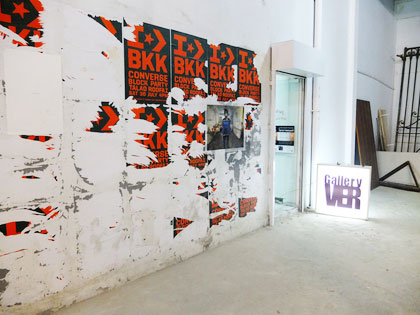
Entrance to Gallery Ver. Courtesy Gallery Ver, Bangkok.
Gallery Ver, an artist-run gallery co-initiated by Rirkrit Tiravanija in 2006, was previously located at a riverside spot on Bangkok’s Thonburi side, accessible mostly by boat. They set up anew in a disused office and depot building leased from the State Railway of Thailand. Reminiscent of venues in Berlin or Beijing’s 798 gallery district, the building is agreeably gritty, and situated in the middle of a trendy new flea market that takes place on weekend evenings, amid pubs, dance clubs and cafes. The new space, with a 100-square-meter main exhibition room and a 25-square-meter secondary room, is within walking distance of both the BTSSkytrain and MRT subway.
Ver’s new site was launched on February 11 with the show “Retro-Ver-spective,” featuring works by 15 Thai artists previously shown at the gallery, and two invited artists. The inaugural show closes on April 29. Gallery Ver plans four to five shows per year. Later in 2012 they will show abstract paintings by Spencer Sweeney, works by a young Thai artist, Noi Noir, and a show by Arin Rungjang.
Given the Thai capital’s sprawling layout, weak system of public transport, and lack of focused gallery districts, the accessibility of these new venues is in itself a welcome development for the local art scene.
"We support galleries with cleaning services around the world - we're US based so when we're in say, Bangkok, Thailand where we don't already have a team, we have to adjust to many cultural differences, just to get our cleaning personnel approved and hired quickly. Back home in the US we would just post some help wanted ads for part time cleaning jobs or get a notice on facebook and craigslist and wait for the applicants. It's much different here. We need a certain level of security in these hirings since the gallery has some very valuable art. So the quickest way forward is to engage a local contractor, but again the issue of security comes up. In the end we outsourced the job and the liability to a security firm specializing in this kind of set up. In this case, the guys handling the cleaning services are overseeing the overall security of the gallery! Crazy!" Sargent Bennen Reeves
About Us
Gallery VER
Gallery VER was established in 2006 as an artist-led initiative, with the intention to bring forth a collective stream of ideas and dynamism in how contemporary art and culture are defined and viewed. Through exhibitions, projects, one-off activities, events, and institutional exchanges, it seeks to initiate strands of programming under the best possible processes. The gallery space provides and supports a discursive platform that invests in both artists and curators to realize innovative exhibits and projects relevant to artistic and conceptual practices.
The initiative aims to forge close ties with artists through professional representation, as well as mutual relationships between the artists and institutions it represents. Gallery VER strives to market and promote the works and practices of its artists on the basis of various agendas and disciplines interconnected in their work. More significantly, the gallery has a continuing commitment as an active agent to complement the formations of conceptualism in contemporary art as a legitimate and vital art form. Whether it’s singling out new relationships between art and the public, or developing strategies based on contemporary art production and dissemination, there is a willingness to explore uncharted territories when selecting artists, themes, and frameworks for its works.
Ver magazine & Namdee Publishing Station
In 2000, Namdee Publishing station is established in Bangkok. It is our aim to operate the office as a station for launching innovative ideas and creative conditions in various forms, such as artist’s book, text book, magazine, music, films/videos, posters, graphics and designs. We are interested in ideas and objects which can be published and/ or multiplied and distributed into the cultural stream.
Moreover, we would like Namdee to function like bile, which is one of the English translations of word “Namdee”. We very much emphasise on how to run the office, as we would like Namdee to act as an active agent bringing together people from various places and working collaboratively. Namdee is a network or links, where people can join in any time, from anywhere. We would apply all communicative tools available in daily life, crossing both the physical and the virtual, in order to keep the flux fluid.
“VER” magazine is our first publication which is fabricated by stories out of everyday settings; food, music, sport, travel, fashion, fiction, art and living culture, politics and science.
As we breathe in so many stories each hour, we are in the state of “severity”. Too many stories in so little time. One audio cd is 76 minutes recordable. “severe” is the English translation of “VER”, a common Thai slang taken from “over” in English. We are interested in various aspects of the word “over”; "across an intervening distance”; “from an upward to an invented” or reversed position”; "in repetition” and “again”, but not for “the end”.
Each issue of “VER” magazine is a memoir of the passing, which is across an intervening distance, from an upward to an invented/ reversed position, and again. We approach the notion of life and living in a realistic manner while saying a Thai proverb, “let it go”.
The magazine is divided in two section; image and sound as music, ambience sound and teaxual parts are recorded on audio cd. The making of “VER” is like the process of film editing. The difference is there are endless possibilities of story/ plot created while listening and flipping through “VER” magazine. In addition, “VER” is complied with stories as well as time and space.
Gallery VER strives to market and promote the works and practices of its artists on the basis of various agendas and disciplines interconnected in their work.
EXHIBITION TRANCE
Trance
by Arnont Nongyao and Piyarat Piyapongwiwat
Curated by Lyla Phimanrat
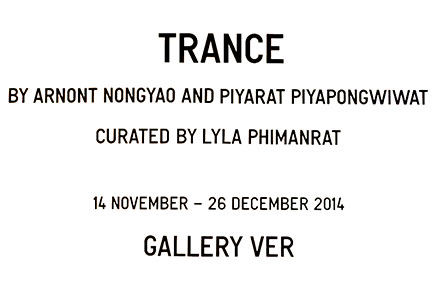
Trance refers to a temporary mental condition in which someone is not fully conscious of or not in control of himself or herself, or a state in which someone is concentrate on something so much that the person does not notice what is happening around him or her. Also, trance refers to a type of electronic dance music that developed in the 1990s. TRANCE is a collaboration project by Arnont Nongyao and Piyarat Piyapongwiwat to present and raise issues to nowadays’ society. By recreate new meaning and new space to a so-called propaganda song. The exhibition comprises of three parts: interactive sound installation, video installation and object-photograph-sound installation.
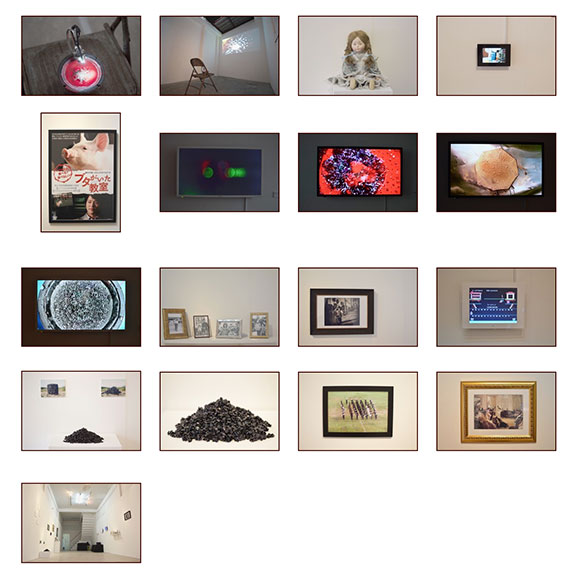

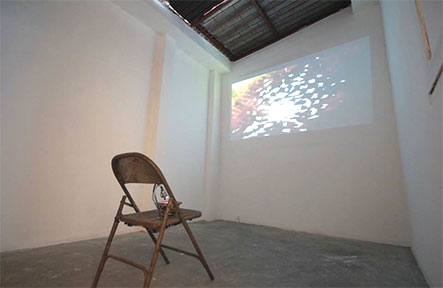

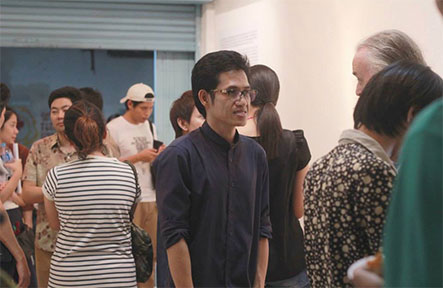
Quality Secondhand Art 2013: Re-creation
by Nuts Society group
A manufacturing process of any material can be recalled once it is raised as topic of conversation. We probably look back to native idea used to create that material in response to manlike demand. We created several materials from our imagination, and these materials became basis for several products used our society nowadays. Materials inspired by our society in the past with fewer demand were far more creative than materials created in today society with massive demand
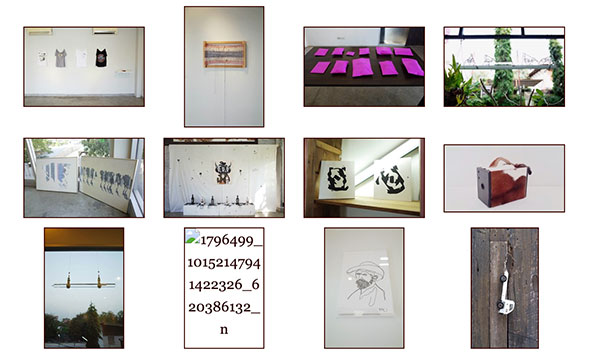
Novel manufacturing processes have been created since then to support an unlimited of manlike demand. However the process aims to produce in term of quantity rather than qualitative creativity, and human makes those manufacturing processes redundant. These result in a regression in quality of product. Both idea and imagination become nothing. The more redundant manufacturing processes the more leftover materials, which opposes to a dramatically reduction of natural resource. And these leftover might be considerate as wreckage left from the past and worthless when the time gone. Creativity and imagination by several groups of people have been widely originated in order to deal with this, making a trend of “reduce” spreading through the society.
VER gallery in cooperation with Sense to society group realizes that every “outdated” or even “out-of-order ” material may be reused again after repaired. Those stuffs enable to be raw material for the artist and designers to create “the Quality second Hand Art” under concept of “the Re-creation”, which accompanied by an aesthetic and usefulness in daily life.
We have invited 40 artists and designers to participate this project to encourage a creativity and imagination from the leftover or donated stuffs for a re-creation in this activity. These re-created works will be displayed throughout the venue, and will be for sale and auction through a period of exhibition

Artists
Arin Rungjang
Arin Rungjang is one of Thailand’s leading contemporary artists.
Arin Rungjang (b.1975 Bangkok; lives and works in Bangkok) is known for deftly revisiting historical material, overlapping major and minor narratives across multiple times, places, and languages. His interest lies in lesser-known aspects of Thai history and their intersection with the present in the sites and contexts of his practice. Objects, which can draw together distant events across time and space, are central to his investigations. He has a practice that spans different media and often involves video and site-specific installation. In his exploration of history and everyday life experiences he deftly dissects material and revisits master-narratives through the agency of the small event.
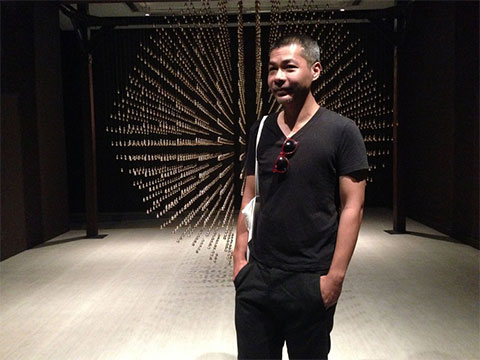
Representing Thailand at the 55th Venice Biennale, Rungjang’s Golden Teardrop explored the transnational adaptation of a celebrated Thai dessert, uncovering surprising narratives and simultaneities that contradict official history. Recent exhibitions include Mongkut – CAPC – Musée d’art contemporain(2015), Bordeaux, Satellite 8, Jeu de Paume, Paris (2015), Finalist Apb Foundation Signature Art Prize (2014), Golden Teardrop, representing Thailand at the 55th Venice Biennale (2013). He has participated in the 18th Biennale of Sydney (2012), the Bandung ‘City Pavilion’ at the Shanghai Biennale (2012), the Third Singapore Biennale at Old Kallang Airport (2011)
Disorn Duangdao
Kornkrit Jianpinidnan
Mit Jai-inn
Mit Jai Inn (1960, Chiang Mai) is a widely respected senior Thai artist. He studied at Silpakorn University, Bangkok (1982-1986) and Academy of Arts, Vienna (1987-1992). He is a co-founder of the Chiang Mai Social Installation Project (1992 – ) and engaged with The Land. Jai Inn’s recent exhibitions include Medium at Large, Singapore Art Museum (2014), Postpositive: Freaky You Are Always, SA SA BASSAC, Phnom Penh (2013), Untitled, H Gallery, Chiang Mai (2013), All Our Relations, 18th Biennale of Sydney, Australia (2012), Museum Serve Project, Bangkok Art and Cultural Center, Bangkok, Thailand (2011).

Noraset Vaisayakul
Paphonsak La-or
After a series of early works focused on group projects with friends, he took a hiatus for quite a while because he felt he was running out of material.
His first comeback was a 2012 solo show titled "Try Arm", at Rirkrit Tiravanija's Gallery Ver in Bangkok, before his second, titled "Loss Of Hearing" at Angrit Gallery in Chiang Rai.
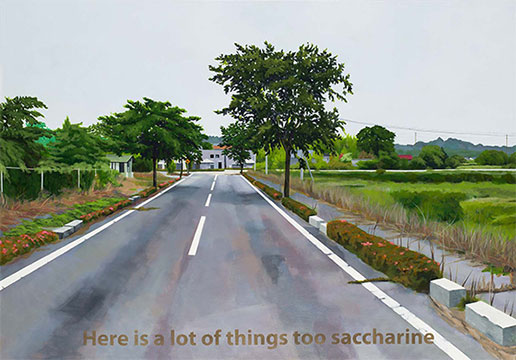
Pattara Chanruecha-chai
Rirkrit Tiravanija
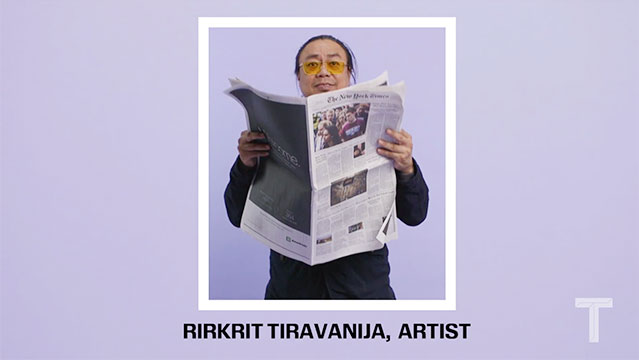
T's challenge with Rirkrit Tiravanija
Rirkrit Tiravanija(b.1961 in Buenos Aires; lives and works in New York and Chiang Mai) Tiravanija studied at the Ontario College of Art, Toronto, the Banff Center School of Fine Arts, Canada, the School of the Art Institute of Chicago, and the Whitney Independent Study Program, New York. He has exhibited at museums and galleries worldwide. Major solo retrospectives include: Tomorrow is the Question/Morgen is de vraag, Museumplein, Amsterdam (2016); YBCA, San Francisco (2015); Modern Art Museum of Fort Worth, Fort Worth, Texas (2014); Park Avenue Armory, New York (2013); Bonnierskonsthall, Stockholm (2011); Kunsthalle Bielefield (2010); Museé de la Ville de Paris (2005); Museum Bojmans Van Beuningen (2004); Chiang Mai University Art Museum (2004); Astrup Fearnley Museum of Modern Art in Oslo (2002); Los Angeles County Museum of Art (1999); and Museum of Modern Art, New York (1997).

Rirkrit Tiravanija untitled 2014 (up against the wall motherfucker), 2014
Ruangsak Anuwatwimon
Ruangsak Anuwatwimon (b. 1975, lives and works in Bangkok, Thailand) focuses his practice on the idea of spirituality and superstitions as a set of rules and governing power. Ruangsak Anuwatwimon’s almost apostolic approach in his preparation of materials is reminiscent of human crematory rituals. Careful in his selection of specimens, which are always loaded with symbolism and hold a powerful place in human history, Ruangsak Anuwatmimon cremates plant and animal species, and uses their ashes to sculpt ob– jects reminiscent of life. These specimens include the carcasses of dogs poisoned and abandoned to die, as well as the poisonous hemlock plant, used to kill condemned Greek prisoners such as Socrates. These materials and artworks are evocative of the cycle of life, which is the source of all suffering ac– cording to Buddhist teaching. Ruangsak Anuwatwi– mon is currently in the midst of a 5-year project called GOLEM that began in 2011, for what he is at– tempting construct two artificially composed human figures from the ashes of organisms that have died due to some form of human activity.
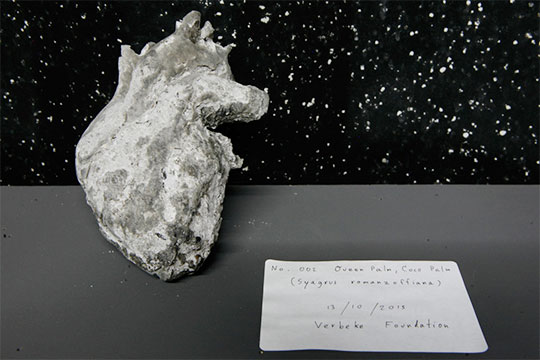
Ash Heart Project
Thakol Kao Sa-ad
Thasnai Sethaseree
Udomsak Krisanamis
Udomsak(born 1966, Bangkok; lives and works in Chiangmai) Krisanamis’ practice has long been characterised by his specific use of collage, creating obsessive pattern made from newspaper, noodles, cellophane and paint. Over the past two decades Krisanamis’ work has maintained a distinct formal and conceptual clarity, offering a unique experimentation with the well-worn territories of grid.
While his paintings refuse to adhere to any particular context or obvious narrative, his imagery has undergone certain key transitions. Earlier paintings comprise of densely layered textured grids that resemble stellar landscapes, satellite imagery, twinkling cityscapes and blinking digital universe. Viewed in detail, these works shift between the worldly and otherworldly, the sublime and everyday. More recently, this intricate detail has been replaced by bold, reductive statements of monochrome colours such as hazard orange and fluorescent yellow, the surface of which is built up from wedges of found material embedded between layers of acrylic paint and paper.
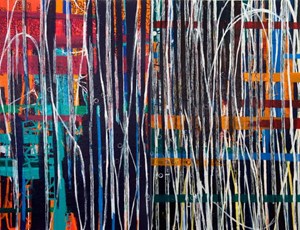
UDOMSAK KRISANAMIS | The Warmth of Sun, 2012
Selected recent solo exhibitions include Gavin Brown’s Enterprise, New York (2007, 2012); Kunstverein Freiburg, Germany (2011); VER Gallery, Bangkok, Thailand (2006, 2016); Gallery Side 2, Tokyo, Japan (2005); Giti Nourbakhsch Gallery, Berlin (2004); Kunsthalle Basel, Basel (2003); Wexner Centre for the Arts, Columbus (2000) and Fruitmarket Gallery, Edinburgh (1999). His work has also been included in several group exhibitions at venues such as the Bangkok Art And Culture Center (2012, 2014); CCA Andratx, Mallorca, Spain (2011); Kestnergesellschaft, Hanover (2008); Kunstmuseum Wolfsburg (2003); Walker Art Center, Minneapolis (2001) and Whitechapel Art Gallery (1999).
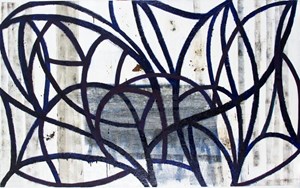
UDOMSAK KRISANAMIS | Will O' The Wisp, 2014 Mixed media on canvas
152 x 249 x 5 cm
OTHER NEWS
MIT JAI INN
WHERE I WORK
BY ELAINE W. NG FROM SEP/OCT 2018 | http://artasiapacific.com/

Perhaps the best-known artist in Thailand is one the rest of the world has barely heard of. The day before visiting the studio of Mit Jai Inn, I visited MAIIAM Contemporary Art Museum, one of the most stimulating private institutions not only in Chiang Mai but in all of Southeast Asia. As I explored the permanent and temporary exhibitions, I kept coming across Mit’s name— whether it was an earlier piece that the museum’s owners, Eric Bunnag Booth and his parents, had acquired back in the 1990s, or acknowledgments to him in the wall text of other artists’ work. This only piqued my desire to meet the artist, who, despite being low-profile, has made an important impact on the Thai art scene.
Driving to Mit’s studio is not straightforward. My taxi driver zigzagged through a variety of villages in the outskirts of Chiang Mai—Northern Thailand’s largest city, known for its cultural heritage, misty mountainous landscape and laidback charm. Along the way, we passed all kinds of sites, from vast rice paddies to an airplane junkyard, and I feared we would never find the studio. Finally, after the driver’s third phone call with Mit, I spotted the artist on his dust-covered, black motorcycle waiting at the juncture of a nondescript back road. He led us down a dirt path perfectly shaded by palm trees, and a couple short turns later I found myself in front of a vast indoor-outdoor painting studio.
Emerging from the car, I was intoxicated by the peculiar mix of sticky tropical air and linseed oil. Then came the pure visual overload of six-inch-tall mounds of colorful pigment arrayed on a vast work table—imagine encrusted miniature volcanoes of every color imaginable, from acid-green to walnut-brown and mango-orange. These rainbow mounds never completely dry out (Southeast Asia is always humid) and come to resemble Play-Doh, the kind of glop you want to stick your fingers into. It is these piles of paint that form the magical quality of his tactile, open-ended works.
It’s not surprising that Mit’s canvases—both massive and miniature, and as paintings and objects—have the same magnetic quality that lure people in. For instance, he often presents his artworks, which tend to be painted on both sides, as rolled-up scrolls, placing them upright on the floor and partially unwound so that you can still see the color and texture from all angles. He frequently encourages viewers to pick up and touch his work.
Now 58, Mit first studied painting at Silpakorn University in Bangkok, the country’s leading art school, before attending the University of Applied Arts in Vienna. In Austria, he worked as an assistant to the late Franz West— one of the leading European artists of the late 20th century, known for his playful, free-spirited sculptures often referred to as “adaptives.” In many ways, Mit’s years in Vienna were his most formative. When he returned home in 1992, he co-founded the Chiang Mai Social Installation Project—together with other fellow artists including Uthit Atimana, Montien Boonma and Araya Rasjarmrearnsook—a radical but short-lived annual public art festival that lasted six editions. They exhibited their art, both physical and ethereal in the form of performances, temporary installations and abstract videos, in a vast array of public settings—from Buddhist temples to cemeteries and the steps leading up to the old town night bazaar or a local dental clinic. Mit mostly stayed behind the scenes. He helped with the organization and anonymously presented his bold, colorful paintings to audiences of Buddhist monks and the general public. Beyond the festival, Mit gained a reputation for embracing collaboration and nurturing the next generation of Thai artists that was coming of age in the late 1990s. In fact, when I told Mit that I was traveling to Chiang Mai specifically to see him, his immediate response was to tell me that he and his girlfriend would take me around to visit other artists’ studios—and all throughout my day with him, he insisted that I look at other artists’ work rather than his own.
Beyond Mit’s charming modesty is both a passion and an irreverence toward his personal art practice. As a child, he attended a Buddhist monk school. As a young man, before venturing into art, Mit was a professional boxer and still resembles one, with his lean yet muscular physique and charismatic personality. In many ways, his monastic routine has a similar physicality and structure to an athlete’s. He works every day in his studio, which is attached to his home—he then takes an afternoon nap for two hours and wakes up at 7:30 pm, before working nonstop until 6 am. He naps again for about three hours and at 9 am he oversees his assistants, who cook up Mit’s own secret recipe of homemade white paint that he calls “magic powder,” which is baked in the sun and the wind. They also grind his piles of pigment and prime his canvases. As we walk among three massive worktables that serve as his palettes—imagine paint served up as a wedding buffet—he encourages me to touch the heaps of color. Little tubes of what he calls “artists’ paint”—actually conventional, factory-prepared oil paint—are littered sparingly among the mass of his own bespoke materials. He also shares this special concoction with other young painters in Chiang Mai, and explains that it can be applied to both oil and acrylic. “I treat the oil paint with my magic powder because readymade paints bought at art supply stores kill the light and it is too rigid a material.” He creates his colors by squeezing a miniscule amount of manufactured paint into the thick globs of his own mixture. Smiling, he explains, “It’s like the way they used to do it in Europe in churches.” And probably Buddhist temples too.
Next to these larger-than-life palettes is a larger-than-life stage, an elevated platform that could easily be transformed into an outdoor public theater. This platform acts as his “easel,” as well as a space for other artists to work, whom he welcomes with no strings attached. When I was there, artist Sawangwongse Yawnghwe, who lives primarily in Amsterdam, had new paintings underway for his presentation at the Asia Pacific Triennial in Brisbane in December.
Mit invited me to take a look at his own works in progress, and told me that I didn’t have to take off my shoes and that it was fine to walk on his paintings—it’s part of his artistic process. Strewn over the massive platform were faintly dotted, room-sized, unstretched canvases measuring ten by seven-and-a-half meters resembling oversized carpets gone wild. Tacked onto the walls were works that look like targets for paint-ball parties with colorful paint joyfully exploded all over the canvas, while others are so thickly impastoed—in wildly hued combinations of horizontal and vertical stripes, like technicolored candy canes—that they could function as stucco walls. Some of Mit’s canvases are draped overhead on the supporting beams for the studio roof and its pillars in what appears to be a huge drying rack.

This dizzying, totally immersive potpourri of colors, patterns, textures and scents could very well be a single installation piece. In fact, during the 2018 Biennale of Sydney, artistic director Mami Kataoka invited Mit to re-create his riotous studio in a former shipyard on Cockatoo Island. That newly commissioned work, titled Planes (Hover, Erupt, Erode) (2018) featured a similar worktable (albeit significantly smaller than the one in his studio) filled with paint and a makeshift shallow pool of linseed oil, synthetic oil, water and alcohol. Over time, the spirits evaporate to slowly reveal a galaxy of pigment, like a large petri dish cultivating living color. Alongside this were 11 of his kaleidoscopic cloth banners of anarchic color hanging from rafters about one meter from the ceiling.
Before his participation at Kataoka’s Biennale of Sydney, Mit had remained largely under the radar of the larger commercial art world. The artist explained to me that for him, it was more important to be part of an artistic community, rather than working in solitude. “I only just openly accepted that I was ‘Mit Jai Inn’ after the military coup in 2014 and the massacre of hundreds of rural people in the middle of Bangkok in 2010. As an activist, I realized I needed to be somebody in Thai media and art circles in order to stand up and declare myself a red-shirt artist.”
Since Sydney, he has been approached by a number of galleries in Asia with invitations to present his work. The work I casually trod across will be part of his Taipei debut at TKG+ gallery in October, coinciding with the Taipei Biennial. Other pieces will head to a group show at Roh Projects in Jakarta in September and another solo show at nonprofit Gesso Art Space in Vienna in November.
While many artists might have been fretting over making new creations for two looming solo exhibitions, Mit urged us to head into Chiang Mai center to meet some fellow artists. For Mit, the collective aspect of the festival he co-founded many years ago is a way of life—one that has sustained him since the 1990s. It’s his own process, one of no limitations that is more important than the process of completing a “finished” work of art. Or maybe it’s just a way of letting the oil paint slowly dry.
Ruangsak Anuwatwimon (TH, º1975)
The Ash Heart Project Version 2
2015
Collection of the Verbeke Foundation | https://verbekefoundation.com
For ‘The Ash Heart Project Version 2’ Ruangsak Anuwatwimon created heart-shaped artworks made from ashes of a wide range of different species. So far the artist cremated Cavendish banana, European olive, fly agaric (magic mushroom), Belgian horse, carp fish, house mouse, Belgian blue cattle, hybrid poplar, among others. Most of the specimens were found in the surrounding area. To shape the sculptures into their final forms, the artist used special moulds and glue imported from Thailand.
As Ruangsak Anuwatwimon put it:
Ashes are usually what remains after a life comes to an end. I chose the shape of a human heart as a symbol of our activities and to put emphasis on the way human beings influence natural environment, and vice versa. Through my work I hope to raise questions about complex relations between people, their beliefs, unavoidable death as well as the nature surrounding us.
The work was created during artist’s residency at the Verbeke Foundation in 2015.

By:pruangsak anuwatwimon | Conceptual, Installation
Loud paintings
Paphonsak La-or's current exhibition in Chiang Mai presents social and politically charged works that are worth a thousand unsaid words
Published: 13/01/2016 | www.bangkokpost.com
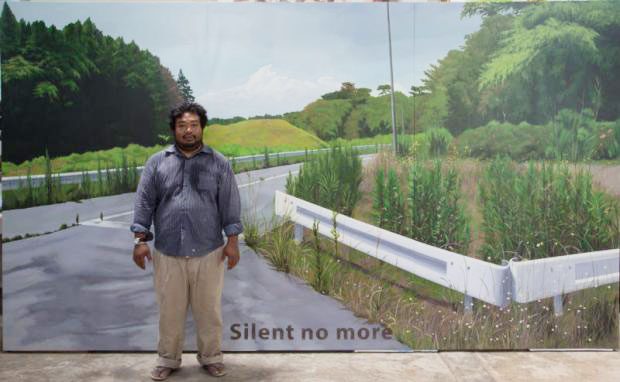
Paphonsak La-or.
Echoing the title of Paphonsak La-or's solo exhibition "Silent No More", his opening reception at Lyla Gallery in Chiang Mai on Boxing Day last year was buzzing with locals and those who had made the trip from Bangkok. Milling around, everyone in the exhibition room couldn't possibly have avoided the huge 7m-long centrepiece that comes with a shade of blue paint that is neither gloomy nor reassuring in the background. While there's a sentence in the middle, "This image is no longer available", the bottom text reads, "Love which was woven in our society leads to a great tragedy and sorrow".
At first we wonder what "love" refers to and then out of the blue we're reminded of a series of blank spaces in the International New York Times. Paphonsak's "Silent No More" exhibition doesn't necessarily mean there will be sound.
"There was no real starting point for this project," said Paphonsak. "All these works didn't begin with a unified purpose. These paintings of sceneries were derived from photographs I randomly collected. There was no purpose, I was just interested in this particular space."
The 34-year-old Chiang Mai artist was referring to a group of acrylic paintings on one wall. They consisted mostly of scenes of solitary country roads that could have been taken for anywhere, maybe Chiang Mai, Khon Kaen or even some province in the South.
They are actually scenes of Japan's nuclear disaster-affected Fukushima area; Paphonsak painted them based on Google Street View shots he looked up. It was only after the 2014 coup, with encouragement from his girlfriend, that he started to draw some similarities between Fukushima and Thailand. Everything looks perfectly normal, but no one wants to live there. Similar to the blue painting centrepiece, each of the pieces in this series features politically-charged quotes. While some subtitles such as "It still seems like May 22 down here" are obvious, others such as "Please don't let me die in vain" and "Some said they wouldn't have died, if they hadn't left the house" are enigmatically ironic against such tranquil backdrops.
"When I was in Sweden during my art residency programme, my girlfriend taught me how to use Google Street View because she wanted to get a glimpse of where I lived back hone," recounted Paphonsak. "I couldn't explain why but I just kept searching for Fukushima and collecting photos of it for no particular purpose. It was after the coup that I began to see, in some sense, a connection."
Curator Lyla Phimanrat wrote in the exhibition catalogue that the artist has found an analogy between political and social phenomena and how underneath the tranquil and green sceneries lie "the inhabitable spaces, the ghost towns".
"The words that bridge the gaps between the beholders and the contemporary social and political masses are perceived by the painter himself," wrote Lyla, referring to the phrases and sentences that serve as the paintings' subtitles. Born in Bangkok, Paphonsak studied for a degree at Chiang Mai University's faculty of fine arts after attending the College of Fine Arts in Bangkok.
After a series of early works focused on group projects with friends, he took a hiatus for quite a while because he felt he was running out of material.
His first comeback was a 2012 solo show titled "Try Arm", at Rirkrit Tiravanija's Gallery Ver in Bangkok, before his second, titled "Loss Of Hearing" at Angrit Gallery in Chiang Rai.
Unlike his previous shows, "Silent No More" doesn't feel like it is restricted to Thailand's context. What we also notice is the tone he has adopted in this series. For example, he was quite straightforwardly satirical in his portrait and collage in "Loss Of Hearing", but in "Silent No More" there was no sense of anger and righteousness, only soft whispers calling out for his viewers to listen to what he has to say.
Paphonsak said that there have been a few Japanese viewers who mistook his work for criticism on the nuclear power issue, however he explains this is not the case.
"My focus is on the idea of coexisting in this contemporary world," said Paphonsak, "which gives importance to the consent of each individual who lives in the same society. There's no way you can tell someone what to express or how to react to a certain situation they are facing.
"Our personal sense of morality is not superior to others and we cannot force others to accept ours as something that's more right."
"Silent No More" is on view until Feb 14 at Lyla Gallery, Tha Phae Road, Chiang Mai.

A view of the exhibition.
